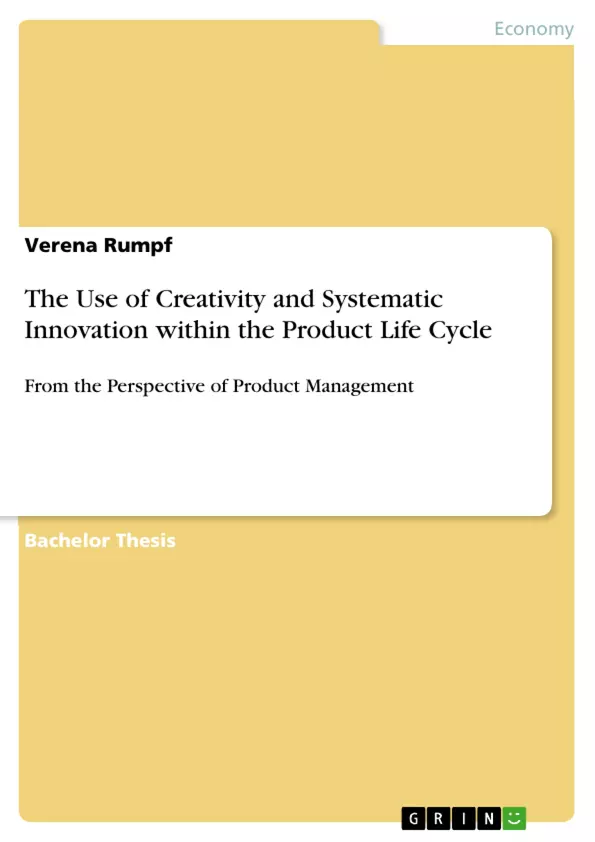
The Use of Creativity and Systematic Innovation within the Product Life Cycle
Bachelorarbeit, 2009
66 Seiten, Note: Gut
Leseprobe
Table of Contents
- 1 General
- 1.1 Introduction
- 1.2 The Target Group
- 2 Basics
- 2.1 Product Management
- 2.1.1 Main Tasks of Product Management
- 2.1.2 Connection to Creativity and Innovation
- 2.2 Creativity and Innovation
- 2.2.1 Basics
- 2.2.2 Factors for Creativity and Innovation
- 3 Selection of Techniques and Tools
- 3.1 Creativity Techniques
- 3.2 Systematic Innovation Tools
- 4 Use of Creativity Techniques and SI Tools within the PLC
- 4.1 Product Life Cycle
- 4.2 Checklist for the Use of Techniques and Tools
Objectives and Key Themes
This paper aims to explore the application of creativity techniques and systematic innovation tools within the product life cycle from a product management perspective. It seeks to provide product managers with alternative approaches for enhancing and upgrading existing products, as well as for developing innovative product ideas. The work also investigates the connection between creativity, innovation, and the daily tasks of a product manager.
- The role of creativity and innovation in product management.
- An overview of various creativity techniques and systematic innovation tools.
- The application of these techniques and tools throughout the product life cycle.
- The impact of organizational structure and individual characteristics on creativity and innovation.
- A practical checklist for utilizing these techniques and tools.
Chapter Summaries
1 General: This introductory chapter sets the stage for the thesis, defining the scope of the research and introducing the central concept of enhancing product development through creativity and innovation within the product life cycle. It lays out the importance of meeting customer needs through continuous product improvement, establishing the core objective of the thesis which is the offering of methods for product enhancement and innovation within product management.
2 Basics: This chapter provides fundamental knowledge on product management, defining key tasks such as innovation, variation, differentiation, diversification, and elimination. It then delves into the concepts of creativity and innovation themselves, exploring factors that influence both, including organizational characteristics, personal barriers, and team dynamics. This chapter provides the theoretical underpinning for the practical application of techniques and tools discussed in later chapters.
3 Selection of Techniques and Tools: This chapter presents a curated selection of creativity techniques (like brainstorming, brainwriting, and synectics) and systematic innovation tools (such as 9 Windows, Function Attribute Analysis, and TRIZ). Each technique and tool is described in detail, outlining its methodology and application. This chapter serves as a comprehensive toolbox for product managers, providing practical methods for generating and evaluating new product ideas.
4 Use of Creativity Techniques and SI Tools within the PLC: This chapter focuses on the practical application of the techniques and tools introduced in the previous chapter within the context of the product life cycle (introduction, growth, maturity, decline). It provides specific examples of how each technique or tool can be effectively used in each stage to address the unique challenges and opportunities presented. The chapter culminates in a checklist to guide product managers in selecting and applying appropriate methods at different stages of a product's lifecycle.
Keywords
Product management, creativity techniques, systematic innovation, product life cycle, brainstorming, innovation tools, TRIZ, product development, customer needs, team dynamics, organizational culture.
FAQ: A Comprehensive Language Preview on Creativity and Innovation in Product Management
What is the overall focus of this document?
This document provides a comprehensive overview of applying creativity techniques and systematic innovation tools within the product life cycle, specifically from a product management perspective. It aims to offer product managers alternative approaches for enhancing existing products and developing innovative ideas, while also exploring the link between creativity, innovation, and daily product management tasks.
What topics are covered in the Table of Contents?
The Table of Contents includes sections on general introductory information, the basics of product management and creativity/innovation, a selection of specific techniques and tools, and finally, the application of these techniques and tools within the context of the Product Life Cycle (PLC).
What are the key objectives and themes explored?
Key themes include the role of creativity and innovation in product management; an overview of various creativity techniques and systematic innovation tools; their application throughout the PLC; the influence of organizational structure and individual characteristics; and a practical checklist for utilizing these methods.
What are the key takeaways from Chapter 1 (General)?
Chapter 1 sets the scene, defining the research scope and introducing the core concept: enhancing product development through creativity and innovation within the product life cycle. It emphasizes meeting customer needs via continuous improvement and establishes the thesis's core objective: providing methods for product enhancement and innovation in product management.
What are the key takeaways from Chapter 2 (Basics)?
Chapter 2 provides foundational knowledge on product management (defining key tasks like innovation, variation, etc.) and the concepts of creativity and innovation. It explores influencing factors, including organizational characteristics, personal barriers, and team dynamics, building the theoretical basis for the practical applications in later chapters.
What are the key takeaways from Chapter 3 (Selection of Techniques and Tools)?
Chapter 3 presents a range of creativity techniques (brainstorming, brainwriting, synectics) and systematic innovation tools (9 Windows, Function Attribute Analysis, TRIZ). Each is described in detail, outlining its methodology and application, offering a toolbox of practical methods for generating and evaluating new product ideas for product managers.
What are the key takeaways from Chapter 4 (Use of Creativity Techniques and SI Tools within the PLC)?
Chapter 4 focuses on practically applying the techniques and tools within the PLC (introduction, growth, maturity, decline). It provides examples of how each method can be used at each stage to address challenges and opportunities. It concludes with a checklist to guide product managers in selecting and applying suitable methods at various PLC stages.
What keywords are associated with this document?
Keywords include: Product management, creativity techniques, systematic innovation, product life cycle, brainstorming, innovation tools, TRIZ, product development, customer needs, team dynamics, organizational culture.
Who is the target audience of this document?
The target audience is product managers seeking to improve their product development processes by incorporating creativity techniques and systematic innovation tools. The document provides them with practical methods and a structured understanding of how to apply these methods throughout a product's lifecycle.
Where can I find more information on the specific techniques and tools mentioned?
While the document provides an overview, further research into the specific techniques and tools (such as brainstorming, TRIZ, 9 Windows, etc.) is recommended for in-depth understanding and practical application. Searching for these terms online or in academic databases will yield more detailed information.
Details
- Titel
- The Use of Creativity and Systematic Innovation within the Product Life Cycle
- Untertitel
- From the Perspective of Product Management
- Hochschule
- Campus02 Fachhochschule der Wirtschaft Graz (Innovationsmanagement)
- Note
- Gut
- Autor
- Verena Rumpf (Autor:in)
- Erscheinungsjahr
- 2009
- Seiten
- 66
- Katalognummer
- V135283
- ISBN (Buch)
- 9783640610952
- ISBN (eBook)
- 9783640611447
- Dateigröße
- 782 KB
- Sprache
- Englisch
- Schlagworte
- Cycle From Perspective Management Creativity Techniques Innovation Management Product Management Systematic Innovation TRIZ
- Produktsicherheit
- GRIN Publishing GmbH
- Preis (Ebook)
- US$ 32,99
- Preis (Book)
- US$ 46,99
- Arbeit zitieren
- Verena Rumpf (Autor:in), 2009, The Use of Creativity and Systematic Innovation within the Product Life Cycle, München, Page::Imprint:: GRINVerlagOHG, https://www.diplomarbeiten24.de/document/135283
- Autor werden
- Ihre Optionen
- Vertriebskanäle
- Premium Services
- Autorenprofil
- Textarten und Formate
- Services für Verlage, Hochschulen, Unternehmen

- © GRIN Publishing GmbH.
- Alle Inhalte urheberrechtlich geschützt. Kopieren und verbreiten untersagt.
- info@grin.com
- AGB
- Open Publishing
Der GRIN Verlag hat sich seit 1998 auf die Veröffentlichung akademischer eBooks und Bücher spezialisiert. Der GRIN Verlag steht damit als erstes Unternehmen für User Generated Quality Content. Die Verlagsseiten GRIN.com, Hausarbeiten.de und Diplomarbeiten24 bieten für Hochschullehrer, Absolventen und Studenten die ideale Plattform, wissenschaftliche Texte wie Hausarbeiten, Referate, Bachelorarbeiten, Masterarbeiten, Diplomarbeiten, Dissertationen und wissenschaftliche Aufsätze einem breiten Publikum zu präsentieren.
Kostenfreie Veröffentlichung: Hausarbeit, Bachelorarbeit, Diplomarbeit, Dissertation, Masterarbeit, Interpretation oder Referat jetzt veröffentlichen!
- GRIN Verlag GmbH
-
- Nymphenburger Str. 86
- 80636
- Munich, Deutschland
- +49 89-550559-0
- +49 89-550559-10
- info@grin.com
-









